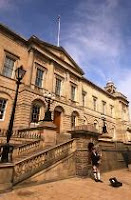

Today marks the 115th anniversary of the discovery of X-rays, and there is a Scottish connection to this crucial innovation. Charles Glover Barkla (left), born in Lancashire in 1877, discovered the polarisation of X-rays and was awarded the Nobel Prize in Physics in 1917.
He was appointed a professor of natural philosophy at Edinburgh University, settling in the Braidwood area of the capital. He held this position until his death in 1944, at the age of 67 (Morningside 685/7, 903).
Charles was married to Mary Esther. They had two sons and one daughter. Their youngest son, Michael, was born in Edinburgh in 1915. A brilliant scholar, he served as a Flight Lieutenant but was killed in action in North Africa in 1943 (155/AF Service Returns).
Barkla's chief recreation was singing - he had a powerful baritone voice and he was a member of the King's College Chapel Choir, 1901-1902. Latterly, he was often to be found enjoying Edinburgh's golf courses.
As well as a plaque in the Canongate near the Faculty of Education Buildings, Barkla has a lunar crater named after him.





 We've added some video footage taken at last year's
We've added some video footage taken at last year's 